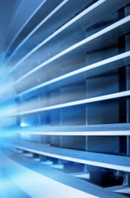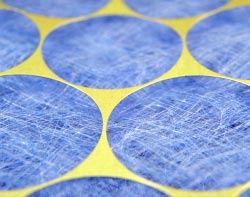| |
|
|
||||||
Air Conditioning CoilsWhen performing routine maintenance on your heating and air conditioning system, be sure not to overlook your unit’s air conditioning coils. Just as air conditioning filters collect dust and debris, air conditioning coils will become dirty over time, and even begin to rust. This air conditioning part must not be ignored if you want to run an efficient home air conditioning system. In standard HVAC systems, air conditioning coils are spiral copper tubes encased in aluminum fins located in both the evaporator and the condenser. Evaporator coils, which can be found indoors, vaporize refrigerant gas, thereby pulling heat out of the indoor air and cooling your home. Their companion part, condenser coils, which can be found outdoors, compresses refrigerant gas back into a liquid, which then carries the heat outside through the coils. Because your air conditioning unit's coils constantly circulate gas and liquid, they are magnets for residue. Over time, your HVAC evaporator coils will accumulate dirt, which reduces air flow and insulates the coil, thus decreasing its ability to absorb heat. Clean evaporator coils contribute to a more efficiently running system and decrease your air conditioning system and refrigeration system's energy bills. In fact, poorly maintained air conditioning coils can reduce the performance of your air conditioner by up to 10%. To combat this, your air conditioner coils should be checked once a year by a trained air conditioning technician, who can clean, repair, and replace the coils as necessary. In addition, regularly changing or cleaning your air conditioner filter, which is conveniently located on top of the evaporator coils, will prevent dirt and debris from collecting as quickly. HVAC condenser coils are also prone to accumulating dirt, especially because they are located outdoors. Snow, ice, dryer vents, falling leaves, foliage, and lawn mowers can all contribute to reduced production from condenser coils. Cleaning the area around the air conditioning coils, removing any debris, and trimming foliage back at least two feet will allow for adequate air flow around the condenser. The method for cleaning air conditioner coils is
similar for the evaporator, or the inside unit,
and the condenser, or the outside unit.
First, unplug the air conditioner, making sure
that no power is still running through the unit. Then
remove the grill protecting the coils, and in the case of the
evaporator, remove the air conditioner filter,
which can be cleaned or changed as necessary. Finally, use
a vacuum cleaner to suck up any dirt and dust on the coils, and
replace the grills (and filter). When cleaning the aluminum
fins on evaporator and condenser coils, take
care not to bend the metal, which can obstruct air flow.
Many air
conditioning companies, including those that manufacture
Honeywell, Rodgers, Lennox, and Carrier coils,
sell a tool called a fin comb, which can be used
to coax the fins back into their original state. Homes with
pets, homes in dusty climates, and homes with high energy usage
might need to change their air conditioning filters and
clean their air conditioning coils more often
to combat dirt and debris. |
| FAQs Resources Sitemap Contact Us Directory All Rights Reserved © Copyright 2007 Air-Conditioning-Filters.com |



